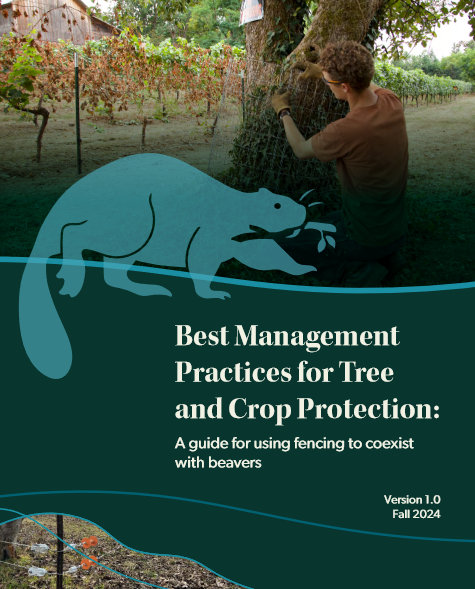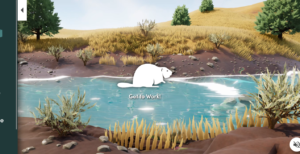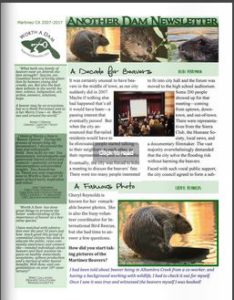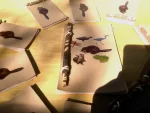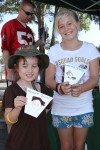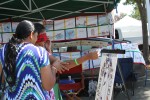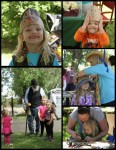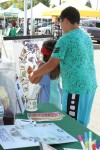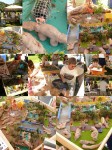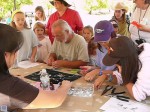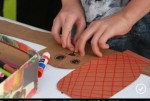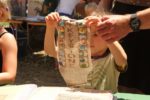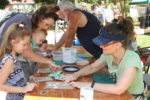 It took longer to arrive than I had hoped. The publication was delayed several times and is still expected to be another 6 weeks for American readers. But this weighty record showing 30 years of beaver watching is definitely worth the wait.
It took longer to arrive than I had hoped. The publication was delayed several times and is still expected to be another 6 weeks for American readers. But this weighty record showing 30 years of beaver watching is definitely worth the wait.
I received my courtesy copy from the publisher Fitzhenry & Whiteside Ltd. last week, and have been engrossed ever since. Everything about this book is impressive: its stunning photographs, gripping account of little known beaver details, and its truly classy lay out, right down to the beaver silhouetted page number in the corner. (I had a good friend who was a copy editor at Random House and I know how much work pulling these details together can be.) I had prepared myself to be impressed, and was not disappointed.
What I hadn’t prepared for was to be surprised.
After nearly 10 years in the beaver biz, reading and writing about them daily, and viewing them regularly at very close quarters, I pretty much thought I had heard and seen it all. Michael Runtz  book was still filled with gloriously unexpected treasures. From the amazing photograph of a beaver floating on its back (yes you read that right, not a sea otter, I swear, he speculates he might be picking a splinter from its teeth with its rear toe) to the exciting collection of facts about their lives, (did you know that when beavers breathe they replaces a whopping 75% of the oxygen in their lungs? Compared to the paltry human rate of 15%!) or that beaver tails in colder climates actually look different in the fall than the spring, depending on how much fat content they’ve lost from it over the winter? Something we’ll never see here in Martinez.
book was still filled with gloriously unexpected treasures. From the amazing photograph of a beaver floating on its back (yes you read that right, not a sea otter, I swear, he speculates he might be picking a splinter from its teeth with its rear toe) to the exciting collection of facts about their lives, (did you know that when beavers breathe they replaces a whopping 75% of the oxygen in their lungs? Compared to the paltry human rate of 15%!) or that beaver tails in colder climates actually look different in the fall than the spring, depending on how much fat content they’ve lost from it over the winter? Something we’ll never see here in Martinez.
If some of the photos seem vaguely familiar they should, Runtz supplied his stills to Jari Osborne’s Beaver Documentary (Beaver Whisperer in Canada, and Nature’s “Leave it to Beaver” in America). My favorite chapters were those documenting beaver effects. First a lovely one showing the biodiversity that blooms in beaver ponds, with beautiful macro photography of gnats, insects, dragonflies, to featherlight photos of birds and water fowl, to richly-textured images of otter and moose you can practically feel. Then a beautifully solemn one about what happens to the trees beavers kill by flooding. (Showing excellent homes for a variety of woodpeckers, wood duck and blue heron). And finally a chapter on the pond’s “afterlife”, what happens when the pond silts up and beavers move on, as the flora take over and the fauna shift accordingly with the flourishing nutrient exchange. Honestly, I was almost in tears through these sections, feeling that they showed better than I ever could hope to explain how powerfully beavers impact biodiversity.
(I wanted to sit every contractor, public works crew, and politician down at the table and force them to look at every page. But that’s just me.)
 Unlike this website, Runtz doesn’t “preach” the beaver gospel. He simply shows it and waits for readers to get the message. There is a short section covering beaver baffles, which is the Canadian flow device that has had good success. He doesn’t talk about the beaver deceiver or its offspring, but I was happy to see him acknowledge problems and explain their solution. A memorable passage describes the anticipation of sitting at a beaver pond before dawn and listening as it comes to life, comparing it to hearing a truly impressive symphony warm up in the darkness before a performance.
Unlike this website, Runtz doesn’t “preach” the beaver gospel. He simply shows it and waits for readers to get the message. There is a short section covering beaver baffles, which is the Canadian flow device that has had good success. He doesn’t talk about the beaver deceiver or its offspring, but I was happy to see him acknowledge problems and explain their solution. A memorable passage describes the anticipation of sitting at a beaver pond before dawn and listening as it comes to life, comparing it to hearing a truly impressive symphony warm up in the darkness before a performance.
With over 200 pages containing stunning photos from one end to the other, this is a book you will look at again and again. I anticipated and missed a forward from some smart researcher like Glynnis Hood or Dietland Muller-Swarze, talking about why his photos are invaluable, but maybe this book isn’t trying to prove that beavers have value. It just shows you that they’re ‘worth a dam’ without ever saying it.
I was especially struck by the final paragraph, when he comments on how children’s minds would be enlivened by a beaver pond, if they could just put down their electronics long enough to get there. It made me think of these 100+ year-old words from my hero Enos Mills in his last chapter of “In Beaver World” where he calls beaver “the original conservationist”.
The works of the beaver have ever interested, the human mind. Beaver work may do for children what schools, sermons, companions and even home sometimes fail to do, – develop the power to think. No boy or girl can become intimately acquainted with the ways and works of these primitive folk without having the eyes of observation opened, and acquiring a permanent interest in the wide world in which we live.
The American version of this unforgettable book won’t be available until (hopefully) mid-september. If you can’t wait, there will be two copies available in the silent auction at our beaver festival. As far as I know they will be the only two copies on American soil in the entire country. I’m guessing that they will be very popular items, so get ready for the bidding war.
















